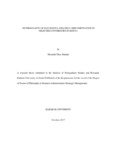DETERMINANTS OF SUCCESSFUL STRATEGY IMPLEMENTATION IN SELECTED UNIVERSITIES IN KENYA
Abstract
A good strategy that is not implemented is as bad as a poor strategy. Emperical evidence postulates that organizations spend more time and effort in strategy development than in strategy implementation. This has led to many organizations’ failure to realize their desired results. This research sought to evaluate determinants of successful strategy implementation in universities in Kenya and identify areas of improvement in the process of strategy implementation. The objectives of this study were: To determine the influence of strategy communication on strategy implementation in universities in Kenya, to establish the effect of organizational leadership on strategy implementation in universities in Kenya, to determine the influence of employee participation in strategy formulation on strategy implementation in universities in Kenya, to establish the effect of resource allocation on strategy implementation in universities in Kenya. This study also sought to establish the moderating effect of organizational culture, systems, and structure on strategy implementation. This study was based on several theories namely; MacKenzie 7s framework, Higgins 8 s framework, Nobble’s strategy implementation framework, Okumu’s strategy implementation framework, and Mintzberg’s 5 ps theory. The research design for this study was cross-sectional descriptive design. This research sought to describe the process of strategy implementation in universities in Kenya and suggest possible changes to improve the process. The target population for this study was all employees in universities in Kenya. The unit of analysis was employees in universities in Kenya. This research studied a sample size of 384 employees in 10 Kenyan universities. The study covered 10 universities in Kenya. The researcher conducted the study in five public universities and five private universities. The universities in Kenya were selected using purposive or judgemental sampling while the employees in each university were selected through stratified sampling. The researcher conducted a preliminary study to select universities that held relevant information for this study. Mainly, those universities that had implemented a strategy before had more relevant information for this research. To obtain the data, semi-structured questionnaires were used in this research. The data were analysed through multiple regression by use of Stata software, SAT System, and Statistical Package for the Social Sciences (SPSS) and then presented in tables, pie charts, graphs, and percentages. This research benefits both business schools and the industry by providing insightful thoughts on the process of strategy implementation. Results show that strategy communication, organizational leadership, resource allocation, and employee participation have positive effect on strategy implementation. Results also show that moderating variables, organization culture and organizational systems have a positive effect on strategy implementation. On the other hand, organizational structure has been found not to have a positive effect on strategy implementation. This study recommends that universities embrace participative style of leadership, do more resource mobilization, and practice performance contacting, ISO certification among other practices.

